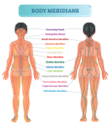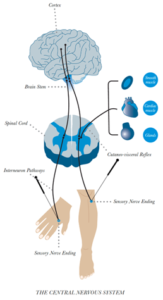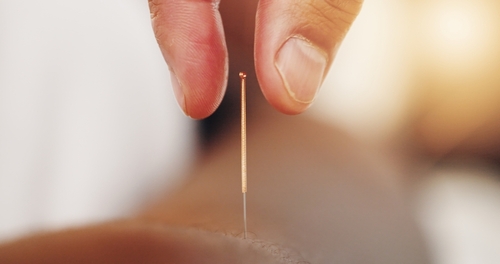 One question that is frequently asked by our acupuncture patients is: “How does acupuncture work?”. Although it is not an easy question to clearly answer, we do enjoy teaching how this ancient healing art is so powerfully helpful.
One question that is frequently asked by our acupuncture patients is: “How does acupuncture work?”. Although it is not an easy question to clearly answer, we do enjoy teaching how this ancient healing art is so powerfully helpful.
Acupuncture is a traditional Chinese medicine (TCM) practice that involves the insertion of fine needles into specific points on the body. It has been used for thousands of years to promote healing and balance the body’s energy, or “Qi.” In recent years, acupuncture has gained popularity in Western medicine, not only for its pain-relieving benefits but also for its effects on various conditions ranging from stress and anxiety to digestive disorders. These are the most common conditions that we treat with acupuncture here in our office.
Historical Background of Acupuncture
Each meridian is associated with specific organs, and acupuncture points along these meridians are used to influence the flow of Qi. Ancient practitioners believed that stimulating these points could unblock stagnant energy, harmonize the body’s systems, and promote healing. While these ideas might seem foreign to modern science, research into acupuncture has demonstrated that the practice does have measurable physiological effects that align with contemporary medical understanding.
Meridians, often described as invisible channels, run throughout the body and correspond to different organs and systems. There are twelve primary meridians, each connected to a specific organ, such as the lung, liver, or kidney. Acupuncture points are specific locations along the meridians where Qi can be accessed and manipulated. By inserting  needles into these points, practitioners believe they can regulate the flow of Qi, either enhancing its movement where it is deficient or dispersing it where it is excessive. This restoration of balance is thought to alleviate pain, improve function, and support the body’s ability to heal itself.
needles into these points, practitioners believe they can regulate the flow of Qi, either enhancing its movement where it is deficient or dispersing it where it is excessive. This restoration of balance is thought to alleviate pain, improve function, and support the body’s ability to heal itself.
While the concept of Qi and meridians may not be directly translatable into Western medical terms, modern research has begun to uncover physiological explanations for how acupuncture works, suggesting that its effects are more than just placebo.
Physiological Mechanisms of Acupuncture
Although acupuncture’s theoretical basis in TCM differs from Western medical models, growing research has identified several physiological mechanisms that may explain its effects. These mechanisms include the stimulation of nerves, activation of pain-modulating pathways, and influence on the body’s immune and neuroendocrine systems.
 One of the primary ways acupuncture is thought to work is by stimulating peripheral nerves, which in turn send signals to the brain. When needles are inserted into the skin, they activate sensory nerves, which can prompt the release of neurochemicals such as endorphins and enkephalins, both of which are natural pain-relievers produced by the body. This release can result in a decrease in pain perception, which helps explain acupuncture’s effectiveness in treating various types of pain, including chronic pain conditions like arthritis, back pain, and migraines.
One of the primary ways acupuncture is thought to work is by stimulating peripheral nerves, which in turn send signals to the brain. When needles are inserted into the skin, they activate sensory nerves, which can prompt the release of neurochemicals such as endorphins and enkephalins, both of which are natural pain-relievers produced by the body. This release can result in a decrease in pain perception, which helps explain acupuncture’s effectiveness in treating various types of pain, including chronic pain conditions like arthritis, back pain, and migraines.
Acupuncture also appears to influence the body’s central nervous system (CNS) by modulating neurotransmitters such as serotonin and dopamine, which play key roles in mood regulation, sleep, and pain sensation. By promoting the release of these chemicals, acupuncture may help alleviate anxiety, depression, and insomnia. Research suggests that acupuncture can even alter brain activity, as shown by imaging studies that have demonstrated changes in areas of the brain involved in pain perception and emotional regulation following acupuncture treatment.
Another important mechanism through which acupuncture works is by reducing inflammation. Inflammation is a common factor in many chronic diseases, including autoimmune disorders, digestive problems, and musculoskeletal pain. Studies have shown that acupuncture can regulate the immune response by decreasing pro-inflammatory cytokines and increasing anti-inflammatory cytokines. This modulation of the immune system not only helps reduce pain but may also improve overall health by addressing underlying inflammatory processes.
Finally, acupuncture has been shown to affect the autonomic nervous system (ANS), which controls involuntary functions such as heart rate, digestion, and respiratory rate. Acupuncture may help balance the two branches of the ANS—sympathetic (fight or flight) and parasympathetic (rest and digest)—leading to a reduction in stress and improved relaxation. By stimulating parasympathetic activity, acupuncture may promote healing by enhancing circulation, digestion, and immune function.
Scientific Evidence and Effectiveness of Acupuncture
In recent years, numerous studies have investigated the effectiveness of acupuncture for various conditions. While the quality of studies varies, the growing body of evidence suggests that acupuncture can be an effective treatment for certain conditions, particularly those involving pain and inflammation.
A comprehensive review by the National Institutes of Health (NIH) concluded that acupuncture is effective in treating chronic pain conditions such as osteoarthritis, chronic low back pain, and headaches. Meta-analyses have also supported acupuncture’s benefits for migraine prevention and the treatment of tension-type headaches. Furthermore, the American College of Physicians has recommended acupuncture as a non-pharmacological treatment option for chronic low back pain based on evidence of its effectiveness.
 For conditions beyond pain management, the evidence is more variable but still promising. For example, acupuncture has been found to be helpful in treating symptoms of anxiety and depression, particularly when used as a complement to conventional treatments like therapy and medication. Other studies have shown that acupuncture can improve symptoms in patients with digestive disorders, including irritable bowel syndrome (IBS), by regulating gastrointestinal motility and reducing inflammation in the gut.
For conditions beyond pain management, the evidence is more variable but still promising. For example, acupuncture has been found to be helpful in treating symptoms of anxiety and depression, particularly when used as a complement to conventional treatments like therapy and medication. Other studies have shown that acupuncture can improve symptoms in patients with digestive disorders, including irritable bowel syndrome (IBS), by regulating gastrointestinal motility and reducing inflammation in the gut.
The overall body of research supports acupuncture as a safe and effective treatment for certain conditions, particularly in pain management and stress reduction. Moreover, acupuncture’s low risk of side effects makes it an appealing alternative or adjunct to more invasive or pharmacological treatments.
Acupuncture and Chiropractic
 Acupuncture and chiropractic care are both forms of complementary medicine that can work synergistically to promote overall health and well-being. While acupuncture focuses on balancing the body’s energy flow through the insertion of needles into specific points along meridians, chiropractic care centers on the alignment of the spine and musculoskeletal system. When used together, acupuncture and chiropractic address both the energetic and structural aspects of health, providing a holistic approach to healing. By targeting both the nervous system (through chiropractic adjustments) and the body’s energy flow (via acupuncture), the combination can enhance pain relief, improve mobility, and support the body’s natural ability to heal itself.
Acupuncture and chiropractic care are both forms of complementary medicine that can work synergistically to promote overall health and well-being. While acupuncture focuses on balancing the body’s energy flow through the insertion of needles into specific points along meridians, chiropractic care centers on the alignment of the spine and musculoskeletal system. When used together, acupuncture and chiropractic address both the energetic and structural aspects of health, providing a holistic approach to healing. By targeting both the nervous system (through chiropractic adjustments) and the body’s energy flow (via acupuncture), the combination can enhance pain relief, improve mobility, and support the body’s natural ability to heal itself.
For instance, patients with chronic back pain may benefit from chiropractic adjustments that correct spinal misalignments, while acupuncture helps reduce inflammation and stimulate endorphin release, providing additional pain relief. Acupuncture can also help relax tight muscles and reduce tension, making chiropractic adjustments easier and more effective. Together, these modalities can address both the mechanical issues in the body and the energetic imbalances that contribute to discomfort and illness.
Furthermore, both acupuncture and chiropractic care emphasize the importance of the nervous system in maintaining overall health. Chiropractic adjustments help realign the spine, which can alleviate pressure on nerves and improve the transmission of signals between the brain and the body. Acupuncture can complement this by influencing the autonomic nervous system, promoting relaxation and reducing stress, which are common contributors to pain and muscle tension. When used together, acupuncture and chiropractic care offer a comprehensive, non-invasive approach to restoring balance, reducing pain, and supporting the body’s self-healing mechanisms.
Conclusion
Acupuncture is a complex and multifaceted practice rooted in ancient Chinese medicine, but its physiological effects are increasingly supported by modern scientific research. The practice operates on the principles of balancing Qi and restoring the flow of energy through the body’s meridians, according to traditional theories. From a Western perspective, acupuncture works by stimulating nerves, modulating neurotransmitters, reducing inflammation, and influencing the autonomic nervous system. While more research is needed to fully understand the mechanisms behind acupuncture and its range of applications, there is strong evidence that it can be an effective treatment for pain, inflammation, and stress-related conditions. As interest in integrative and complementary medicine grows, acupuncture is likely to remain an important part of holistic healthcare approaches for years to come.







